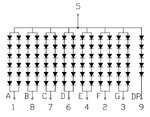saramah
Member level 3

I done clock with RTC, MCU16F887 and the disp used there is 6 digit 7-seg of 1 inch each with Multiplexing.

>> Now I intend to use BIG like, 6" 7-SEG, 6 digit to disp the time instead of 1 inc.
The spec for 6" is below::

It is >CA,
each segment has > 6-row 2 column, If-20ma, Vf-12 volts.
>> I googled and find a ckt for 2.3" attached here,
View attachment 2.3 inch_CA_frm SDGeLECTRONICS.png
here used as Anode driver- ULN2003A (o/p current 500ma per driver pin) and BC327(collector current of 500mA) AND Cathod Driver- ULN2803(collectro current 500ma).
and Each Segments is of 4 RED LED in series, so forward voltage of the segments is 10v(approx).
Power supply for mcu is at 3.3 v used here.
>> Would you please suggest:
in my case-
1) can I use 12 v and 5 volt power supply
2) As Anode driver: can i use same ULN2003A and BC327:
3 As Cathode : can use ULN2803.
tnx

>> Now I intend to use BIG like, 6" 7-SEG, 6 digit to disp the time instead of 1 inc.
The spec for 6" is below::

It is >CA,
each segment has > 6-row 2 column, If-20ma, Vf-12 volts.
>> I googled and find a ckt for 2.3" attached here,
View attachment 2.3 inch_CA_frm SDGeLECTRONICS.png
here used as Anode driver- ULN2003A (o/p current 500ma per driver pin) and BC327(collector current of 500mA) AND Cathod Driver- ULN2803(collectro current 500ma).
and Each Segments is of 4 RED LED in series, so forward voltage of the segments is 10v(approx).
Power supply for mcu is at 3.3 v used here.
>> Would you please suggest:
in my case-
1) can I use 12 v and 5 volt power supply
2) As Anode driver: can i use same ULN2003A and BC327:
3 As Cathode : can use ULN2803.
tnx




